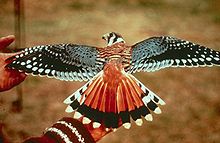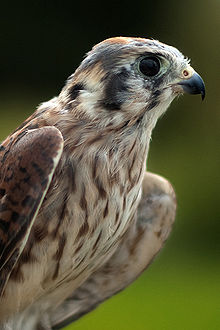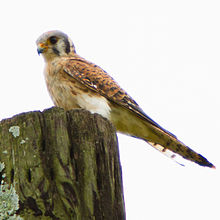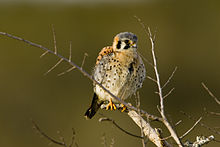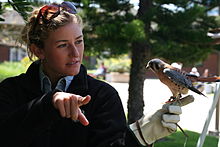- American Kestrel
-
American Kestrel 
Male 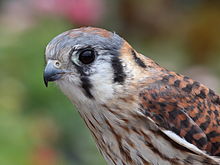
Female Conservation status Scientific classification Kingdom: Animalia Phylum: Chordata Class: Aves Order: Falconiformes Family: Falconidae Genus: Falco Species: F. sparverius Binomial name Falco sparverius
Linnaeus, 1758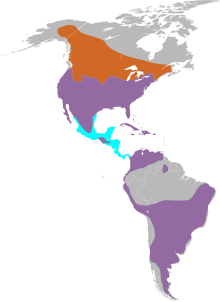
American Kestrel range Year RoundSummer (breeding)Winter (nonbreeding)The American Kestrel (Falco sparverius), sometimes colloquially known as the Sparrow Hawk, is a small falcon, and the only kestrel found in the Americas. It is the most common falcon in North America, and is found in a wide variety of habitats. At 19–21 centimeters (7–8 in) long, it is also the smallest falcon in North America. It exhibits sexual dimorphism in size and plumage, although both genders have a rufous back with noticeable barring. Juveniles are similar in plumage to adults.
The American Kestrel hunts by hovering in the air with rapid wing beats or perching and scanning the ground for prey. Its diet typically consists of grasshoppers, lizards, mice, and other small birds. It nests in cavities in trees, cliffs, buildings, and other structures. The female lays three to seven eggs, which both sexes help to incubate. It is a common bird to be used in falconry, especially by beginners.
Its breeding range extends from central and western Alaska across northern Canada to Nova Scotia, and south throughout North America, into central Mexico and the Caribbean. It is a local breeder in Central America and is widely distributed throughout South America. Most birds breeding in Canada and the northern United States migrate south in the winter. It is an occasional vagrant to western Europe.
Contents
Description
At about the size of a large thrush, the American Kestrel is the smallest falcon in North America.[2] The American Kestrel is sexually dimorphic, although there is some overlap in plumage coloration between the sexes. The bird is 19–21 centimeters (7–8 in) in length with a wingspan of 50–60 centimeters (20–24 in), with the female typically larger than the male. The male weighs 103–120 grams (3.6–4.2 oz), and the female 126–166 grams (4.4–5.9 oz).[3]
In contrast to many other raptor species, the sexes differ more in plumage than in size. Males have blue-grey wings with black spots and white undersides with black barring. The back is rufous, with barring on the lower half. The belly and flanks are white with black spotting. The tail is also rufous, with a white or rufous tip and a black subterminal band.[4] The back and wings of the female American Kestrel are rufous with dark brown barring. The undersides of the females are creamy to buff with heavy brown streaking. The tail is noticeably different from the male's, being rufous in color with numerous narrow dark black bars. Juveniles exhibit coloration patterns similar to the adults'.[4] In both sexes, the head is white with a bluish-grey top. There are also two narrow, vertical black facial markings on each side of the head, while other falcons have one.[5] Two black spots (ocelli) can be found on each side of the white or orangish nape.[6] The function of these spots is debated, but the most commonly accepted theory is that they act as "false eyes", and help to protect the bird from potential attackers.[7] The wings are moderately long, fairly narrow, and taper to a point. While the kestrel is perched, the wingtips are noticeably shorter than the tail tip.[citation needed]
Vocalizations
The American Kestrel has three basic vocalizations – the "klee" or "killy", the "whine", and the "chitter."[8] The "klee" is usually delivered as a rapid series – klee, klee, klee, klee when the kestrel is upset or excited. This call is used in a wide variety of situations and is heard from both sexes, but the larger females typically have lower-pitched voices than the males. The "whine" call is primarily associated with feeding, but is also uttered during copulation. The "chitter" is used in activities which involve interaction between male and female birds, including courtship feeding, copulation, and the feeding of nestlings.[9] Nestlings can produce calls similar to those of adults at 16 days old.[10]
Taxonomy
Until the sixth edition of the AOU Checklist of North American Birds was published by the American Ornithologists' Union in 1983, the most commonly used name for the American Kestrel was the Sparrow Hawk or Sparrowhawk. This was due to a mistaken connection with the Eurasian Sparrowhawk in the genus Accipiter. The sixth edition of the AOU Checklist corrected this, officially renaming the bird American Kestrel. Several other colloquial names for the kestrel are also in use, including Grasshopper Hawk, due to its diet, and Killy Hawk, due to its distinct call.[11]
The American Kestrel's scientific name, Falco sparverius, was given by Carolus Linnaeus in his 18th Century work Systema Naturae.[12] The genus refers to the falcate, or hooked, shape of the beak, and the specific name means "pertaining to a sparrow", referring to the bird's small size and occasional hunting of sparrows.[11]
Seventeen subspecies of the American Kestrel are recognized, generally based upon plumage, size, and vocalizations:[13]
- F. s. sparverius, described by Linnaeus in 1758, is the nominate subspecies. It is found in most of the United States, Canada, and Mexico.
- F. s. paulus, described by Howe and King in 1902, is found in the Southeast United States, from Louisiana to Florida.
- F. s. peninsularis, described by Mearns in 1892, is found in southern Baja California.
- F. s. tropicalis, described by Griscom in 1930, is found from southern Mexico to northern Honduras.
- F. s. nicaraguensis, described by Howell in 1965, is found in Honduras and Nicaragua.
- F. s. sparveroides, described by Vigors in 1827, is found in Cuba and the Isle of Youth, and southern to central Bahamas.
- F. s. dominicensis, described by Gmelin in 1788, is found in Puerto Rico through the Lesser Antilles to Grenada.
- F. s. caribaearum, described by Gmelin in 1788, is found in Hispaniola.
- F. s. brevipennis, described by Berlepsch in 1892, is found in the Netherlands Antilles.
- F. s. isabellinus, described by Swainson in 1837, is found from Venezuela to northern Brazil.
- F. s. ochraceus, described by Cory in 1915, is found in eastern Colombia and northwest Venezuela.
- F. s. caucae, described by Chapman in 1915, is found in western Colombia.
- F. s. aequatorialis, described by Mearns in 1892, is found in northern Ecuador.
- F. s. peruvianus, described by Cory in 1915, is found in southwest Ecuador, Peru, and northern Chile.
- F. s. fernandensis, described by Chapman in 1915, is found on the Juan Fernández Islands off Chile.
- F. s. cinnamominu, described by Swainson in 1837, is found in Peru, Chile, and Argentina.
- F. s. cearae, described by Cory in 1915, is found from northeast Brazil south to eastern Bolivia.
Ecology and behavior
American Kestrels are found in a wide variety of habitats, including grasslands, meadows, deserts, and other open to semiopen regions. They can also be found in both urban and suburban areas. A kestrel's habitat must include perches, open space for hunting, and cavities for nesting (whether natural or man-made).[14] The American Kestrel is able to live in very diverse conditions, ranging from above the Arctic Circle,[15] to the tropics of Central America, to elevations of over 4,500 meters (14,764 ft) in the Andes Mountains.[16] The bird is distributed from northern Canada and Alaska to the southernmost tip of South America, Tierra del Fuego. It is the only kestrel found in the Americas.[17] It has occurred as a vagrant in the UK, Denmark, Malta and the Azores.[18]
American Kestrels in Canada and the northern United States typically migrate south in the winter, sometimes going as far as Central America and the Caribbean. Birds that breed south of about 35 degrees north latitude are usually year-round residents. Migration also depends on local weather conditions.[19] Wintering kestrels' choice of habitat varies by sex. Females are found in open areas more often than males during the non-breeding season. A common explanation for this behavior is that the larger females arrive at the preferred habitat first and exclude males from their territory.[20]
The American Kestrel is not long-lived, with an average lifespan of fifteen months.[21] The oldest banded wild bird was 11 years and seven months old,[22] and the oldest captive kestrel was a 17-year-old male.[21] In a study, humans accounted for 43.2% of 1,355 reported deaths, which included direct killing and roadkills, while predation (including by larger birds of prey) accounted for 2.8%. This statistic is likely biased, however, as reported deaths are usually found near or in areas populated by humans.[23]
Feeding
American Kestrels feed largely on small animals such as grasshoppers, dragonflies, lizards, mice, and voles. They will also eat other small birds. The kestrel has also been reported to have killed larger animals such as snakes, bats, and squirrels.[24] The kestrel maintains high population densities, in part because of the broad scope of its diet. The American Kestrel's primary mode of hunting is by perching and waiting for prey to come near. The bird is characteristically seen along roadsides or fields perched on objects such as trees, overhead power lines, or fence posts. It also hunts by hovering in the air with rapid wing beats and scanning the ground for prey. Other hunting techniques include low flight over fields, or chasing insects in the air.[25]
Prey is almost always caught on the ground. Before striking, the kestrel characteristically bobs its head and tail, then makes a direct flight toward the prey to grab it in its talons. During the breeding season, the bird will carry large prey back to its mate or young. One study found that an American Kestrel pair "foraged in ways that minimized the costs of energy acquisition in its particular situation". For example, if the success rate for catching prey decreases significantly in a particular area, the bird will move to a different area.[26]
Reproduction
American Kestrels are sexually mature by their first spring.[27] In migratory populations, the males arrive at the breeding ground before females, then the female selects a mate. Pair bonds are strong, often permanent. Pairs usually use previous nesting sites in consecutive years. This gives birds an advantage over younger or invading individuals, as they would already be familiar with the hunting grounds, neighbors, predators, and other features of the site.[28] Males perform elaborate dive displays to advertise their territory and attract a mate. These displays consist of several climbs and dives, with three or four "klee" calls at their peaks. Females are promiscuous for about one to two weeks after their arrival at the nesting site. This is thought to stimulate ovulation.[29] Food transfers from the male to the female occur from about four to five weeks prior to egg laying to one to two weeks after.[30]
American Kestrels are cavity nesters, but they are able to adapt to a wide variety of nesting situations. They generally prefer natural cavities (such as in trees) with closed tops and tight fitting entrances, as to provide for maximum protection of the eggs and young.[31] Kestrels occasionally nest in holes created by large woodpeckers,[32] or use the abandoned nests of other birds, such as Red-tailed Hawks, Merlins, and crows.[33] They have been recorded nesting on cliff ledges and building tops, as well as in abandoned cavities in cactuses.[34] American Kestrels also commonly utilize nesting boxes.[35]
Three to seven eggs (typically four or five) are laid approximately 24–72 hours apart. The average egg size is 32 mm by 29 mm, 10% larger than average for birds of its body size. The eggs are white to cream in color with brown or grey splotching. Incubation usually lasts 30 days and is mainly the responsibility of the female, although the male incubates 15–20% of the time. Eggs which are lost are typically replaced in 11–12 days. Hatching takes place over three to four days. Hatchlings are altricial, and are only able to sit up after five days. They grow very quickly, reaching an adult weight after 16–17 days. After 28–31 days, their wings develop and they are able to leave the nest.[36]
Status and conservation
The American Kestrel is the most abundant falcon in North America, although its total population is difficult to quantify, as local populations can change quickly due to resource availability. The North American population has been estimated at 1.2 million pairs, with the Central and South American populations being as large. A smaller estimate is 236,000 birds wintering in North America. A population increase occurred in the 18th and 19th centuries, probably due to deforestation for agriculture. The resulting pastures provided an ideal habitat for kestrels.[23]
Male with handler, San Diego Zoo
The southeastern U.S. subspecies (Falco sparverius paulus) has declined 82% since 1940 due to a decrease in nest site availability. This decline is a result of Longleaf Pines being cleared from agricultural fields.[37] Despite this, the American Kestrel is classed as Least Concern on the IUCN Red List.[1]
Relationship with humans
One important use of American Kestrels is in falconry. Although most falconers prefer larger birds such as Peregrine Falcons and Northern Goshawks when hunting, kestrels can be used to catch small birds, insects, and rodents. American Kestrels are also often used in scientific studies, because they can be bred easily in captivity. By artificially manipulating the daylight hours in captivity, scientists have bred them more than once a year.[38]
Migratory raptors native to the United States are protected by the Migratory Bird Treaty Act of 1918, so American Kestrels are illegal to possess without a permit in the United States, Canada, and Mexico.[39]
References
- ^ a b BirdLife International (2009.0). "Falco sparvarius". IUCN Red List of Threatened Species. Version 2010.4. International Union for Conservation of Nature. http://www.iucnredlist.org/apps/redlist/details/144555. Retrieved 2010-08-08.
- ^ Wauer (2005), pp. 6–7
- ^ McCollough. "American Kestrel Falco sparverius". University of Michigan Museum of Geology. http://animaldiversity.ummz.umich.edu/site/accounts/information/Falco_sparverius.html. Retrieved September 13, 2010.
- ^ a b "American Kestrel, Falco sparverius". Cornell Lab of Ornithology. http://www.allaboutbirds.org/guide/American_Kestrel/id. Retrieved September 13, 2010.
- ^ Tveten & Tveten (2004), p. 210
- ^ Clark & Wheeler (2001), p. 252
- ^ Negro, Juan José; Bortolotti, Gary R.; Sarasola, José Hernán (2007). "Deceptive plumage signals in birds: manipulation of predators or prey?". Biological Journal of the Linnean Society (Linnean Society of London) 90 (3): 467–477. doi:10.1111/j.1095-8312.2007.00735.x. http://onlinelibrary.wiley.com/doi/10.1111/j.1095-8312.2007.00735.x.
- ^ Mueller, Helmut C. (1971). "Displays and Vocalizations of the Sparrow Hawk". The Wilson Bulletin (Wilson Ornithological Society) 83 (3): 249–254. http://elibrary.unm.edu/sora/Wilson/v083n03/p0249-p0254.pdf.
- ^ Wauer (2005), pp. 11–12
- ^ Smallwoood, John A.; Dudajek, Valerie (2003). "Vocal Development in American Kestrel (Falco sparverius) Nestlings". Journal of Raptor Research (Raptor Research Foundation) 37 (1): 37–43. http://elibrary.unm.edu/sora/jrr/v037n01/p00037-p00043.pdf.
- ^ a b Wauer (2005), p. 4
- ^ Linnaeus, Carolus (1758) (in Latin). Systema naturae per regna tria naturae, secundum classes, ordines, genera, species, cum characteribus, differentiis, synonymis, locis. Tomus I. Editio decima, reformata. Holmiae: Laurentii Salvii.. p. 152.
- ^ Smallwood, John A.; Bird, David M. (2002). "American Kestrel: Systematics". Cornell Lab of Ornithology. http://bna.birds.cornell.edu/bna/species/602/articles/systematics. Retrieved 4 September 2010.
- ^ "American Kestrel, Life History". All About Birds. Cornell Lab of Ornithology. http://www.allaboutbirds.org/guide/American_Kestrel/lifehistory. Retrieved 3 September 2010.
- ^ Wauer (2005), p. 15
- ^ Fjeldså & Krabbe (1990), p. 112
- ^ Smallwood, John A.; Bird, David M. (2002). "American Kestrel: Introduction". Cornell Lab of Ornithology. http://bna.birds.cornell.edu/bna/species/602/articles/introduction. Retrieved 2 November 2010.
- ^ Snow, David; Perrins, Christopher M (editors) (1998). The Birds of the Western Palearctic concise edition (2 volumes). Oxford: Oxford University Press. p. 152. ISBN 0-19-850188-9.
- ^ Wauer (2005), pp. 23–24
- ^ Ardia, Daniel R.; Bildstein, Keith L. (1997). "Sex-related differences in habitat selection in wintering American kestrels,Falco sparverius". Animal Behavior (The Association for the Study of Animal Behaviour) 53 (6): 1305–1311. doi:10.1006/anbe.1996.0364. http://www.sciencedirect.com/science?_ob=ArticleURL&_udi=B6W9W-45R7FRT-GH&_user=10&_coverDate=06/30/1997&_rdoc=1&_fmt=high&_orig=browse&_origin=browse&_sort=d&view=c&_acct=C000050221&_version=1&_urlVersion=0&_userid=10&md5=4c5173ddf9488e5d672624366816f7d7.
- ^ a b Wauer (2005), p. 51
- ^ Clapp, Roger B.; Klimkiewicz, M. Kathleen; Kennard, John H. (1982). "Longevity Records of North American Birds: Gaviidae through Alcidae". Journal of Field Ornithology (Association of Field Ornithologists) 53 (2): 81–124. JSTOR 4512701.
- ^ a b Smallwood, John A.; Bird, David M. (2002). "American Kestrel: Demography and Populations". Cornell Lab of Ornithology. http://bna.birds.cornell.edu/bna/species/602/articles/demography. Retrieved 5 September 2010.
- ^ Sherrod, Steve K. (1978). "Diets of North American Falconiformes". Journal of Raptor Research (Raptor Research Foundation) 12 (2): 103–106. http://elibrary.unm.edu/sora/jrr/v012n03-04/p00049-p00121.pdf.
- ^ Collopy, Michael W.; Koplin, James R. (1983). "Diet, Capture Success, and Mode of Hunting by Female American Kestrels in Winter". The Condor (Cooper Ornithological Society) 85 (3): 69–371. JSTOR 136708.
- ^ Rudolph, Seri G. (1982). "Foraging Strategies of American Kestrels During Breeding". Ecology (Ecological Society of America) 63 (5): 1268–1276. doi:10.2307/1938854. JSTOR 1938854.
- ^ Duncan, James, R.; Bird, David M. (1989). "The influence of relatedness and display effort on the mate choice of captive female American kestrels". Animal Behavior (The Association for the Study of Animal Behaviour) 37: 112–117. doi:10.1016/0003-3472(89)90011-0. http://deepblue.lib.umich.edu/bitstream/2027.42/28134/1/0000585.pdf.
- ^ Wauer (2005), p. 52
- ^ Wauer (2005), p. 54
- ^ Smallwood, John A.; Bird, David M. (2002). "American Kestrel: Behavior". Cornell Lab of Ornithology. http://bna.birds.cornell.edu/bna/species/602/articles/behavior. Retrieved 25 September 2010.
- ^ Wauer (2005), p. 55
- ^ Gault, Kathleen E.; Walters, Jeffrey R.; Tomcho, Joseph, Jr.; Phillips, Louis F., Jr.; Butler, Andrew (2004). "Nest Success of Southeastern American Kestrels Associated with Red-Cockaded Woodpeckers in Old-Growth Longleaf Pine Habitat in Northwest Florida". Southeastern Naturalist (Humboldt Field Research Institute) 3 (2): 191–204. doi:10.1656/1528-7092(2004)003[0191:NSOSAK]2.0.CO;2. ISSN 1528-7092. JSTOR 3878098.
- ^ Wauer (2005), pp. 55-56
- ^ Smith, Dwight G.; Wilson, Charles R.; Frost, Herbert H. (1972). "The Biology of the American Kestrel in Central Utah". The Southwestern Naturalist (Southwestern Association of Naturalists) 17 (1): 73–83. doi:10.2307/3669841. JSTOR 3669841.
- ^ Rohrbaugh, Ronald W., Jr.; Yahner, Richard H. (1997). "Effects of Macrohabitat and Microhabitat on Nest-Box Use and Nesting Success of American Kestrels". The Wilson Bulletin (Wilson Ornithological Society) 109 (3): 410–423. JSTOR 4163837.
- ^ Wauer (2005), pp. 59-63
- ^ Hoffman, Mark L.; Collopy, Michael W. (1988). "Historical Status of the American Kestrel (Falco sparverius paulus) in Florida". The Wilson Bulletin (Wilson Ornithological Society) 100 (1): 91–107. JSTOR 4162520.
- ^ Wauer (2005), pp. 75-76
- ^ "Legal Requirements for Raptor Possession". Bureau of Land Management. 15 July 2008. http://www.blm.gov/id/st/en/fo/four_rivers/01/links/raptor_possession.html. Retrieved 29 October 2010.
Cited books
- Clark, William S.; Wheeler, Brian K. (2001). A field guide to hawks of North America. New York, NY: Houghton Mifflin Harcourt. ISBN 0-395-67067-5.
- Fjeldså, Jon; Krabbe, Niels (1990). Birds of the High Andes: A Manual to the Birds of the Temperate Zone of the Andes and Patagonia, South America. Svendborg, Denmark: Apollo Books. ISBN 87-88757-16-1.
- L. Tveten, John; Tveten, Gloria (2004). "Our Smallest Falcon—American Kestrel: 198/1996". Our life with birds: a nature trails book. College Station, TX: Texas A&M University Press. ISBN 1-58544-380-8.
- Wauer, Roland H. (2005). The American kestrel: falcon of many names. Boulder, CO: Johnson Books. ISBN 1-55566-353-2.
External links
- Internet Bird Collection Videos
- South Dakota Birds and Birding Information and photographs
- USGS Patuxent Bird Identification InfoCenter
- VIREO photo gallery
- American Kestrel, Birds of Nova Scotia.
Categories:- IUCN Red List least concern species
- Birds of North America
- Birds of South America
- Birds of Puerto Rico
- Birds of Chile
- Falco
- Fauna of Delaware and Maryland
Wikimedia Foundation. 2010.


